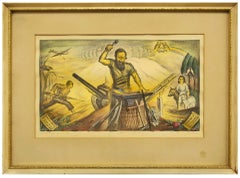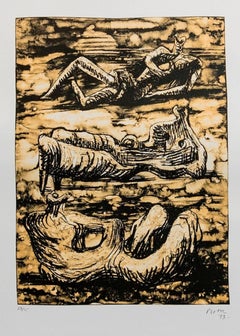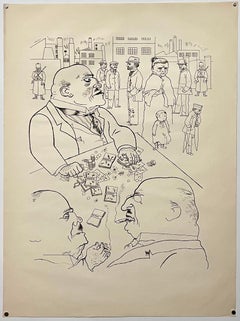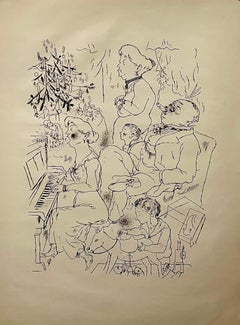Want more images or videos?
Request additional images or videos from the seller
1 of 6
Gershon KnispelMan from the Shtetl (Sholem Aleichem)
$550List Price
About the Item
- Creator:Gershon Knispel (1932, German, Israeli)
- Dimensions:Height: 27.5 in (69.85 cm)Width: 19.5 in (49.53 cm)
- Medium:
- Movement & Style:
- Period:
- Condition:
- Gallery Location:Surfside, FL
- Reference Number:1stDibs: LU3822059763
About the Seller
4.9
Platinum Seller
Premium sellers with a 4.7+ rating and 24-hour response times
Established in 1995
1stDibs seller since 2014
1,846 sales on 1stDibs
Authenticity Guarantee
In the unlikely event there’s an issue with an item’s authenticity, contact us within 1 year for a full refund. DetailsMoney-Back Guarantee
If your item is not as described, is damaged in transit, or does not arrive, contact us within 7 days for a full refund. Details24-Hour Cancellation
You have a 24-hour grace period in which to reconsider your purchase, with no questions asked.Vetted Professional Sellers
Our world-class sellers must adhere to strict standards for service and quality, maintaining the integrity of our listings.Price-Match Guarantee
If you find that a seller listed the same item for a lower price elsewhere, we’ll match it.Trusted Global Delivery
Our best-in-class carrier network provides specialized shipping options worldwide, including custom delivery.You May Also Like
Original 1933 Concours de Photographie e Cinematographie vintage French poster
Located in Spokane, WA
Original 1933 French Poster — Touring Club de France “Concours de Photographie et de Cinématographie” — Art Deco — Linen Backed Vintage Advertising Grade a- condition with minor r...
Category
1930s American Modern Figurative Prints
Materials
Lithograph
$440
H 21.25 in W 15.3 in D 0.3 in
The Rabbit - Lithograph by Paul Gervais - 1854
By Paul Gervais
Located in Roma, IT
The Rabbit is a lithograph on ivory-colored paper, realized by Paul Gervais (1816-1879). The artwork is from The Series of "Les Trois Règnes de la Nature", and was published in 1854....
Category
1850s Modern Figurative Prints
Materials
Lithograph
Uses and Customs - Soldiers - Lithograph - 1862
Located in Roma, IT
Uses and Customs - Soldiers is a lithograph on paper realized in 1862.
The artwork belongs to the Suite Uses and customs of all the peoples of the universe: "History of the governme...
Category
1860s Modern Figurative Prints
Materials
Lithograph
$287
H 7.29 in W 11.23 in D 0.04 in
Uses and Customs - Penelope - Lithograph - 1862
Located in Roma, IT
Uses and Customs - Penelope is a lithograph on paper realized in 1862.
The artwork belongs to the Suite Uses and customs of all the peoples of the universe: " History of the governm...
Category
1860s Modern Figurative Prints
Materials
Lithograph
$263
H 7.29 in W 11.23 in D 0.04 in
Uses and Customs - Women's Head - Lithograph - 1862
Located in Roma, IT
Uses and Customs - Women's Head is a lithograph on paper realized in 1862.
The artwork belongs to the Suite Uses and customs of all the peoples of the universe: " History of the gov...
Category
1860s Modern Figurative Prints
Materials
Lithograph
$239
H 7.29 in W 11.23 in D 0.04 in
Uses and Customs - Trojan e Antoniana Columns - Lithograph - 1862
Located in Roma, IT
Uses and Customs - Trojan e Antoniana Columns is a lithograph on paper realized in 1862.
The artwork belongs to the Suite Uses and customs of all the peoples of the universe: " Hist...
Category
1860s Modern Figurative Prints
Materials
Lithograph
$191
H 11.23 in W 7.29 in D 0.04 in
Uses and Customs - Architecture - Lithograph - 1862
Located in Roma, IT
Uses and Customs - Architecture is a lithograph on paper realized in 1862.
The artwork belongs to the Suite Uses and customs of all the peoples of the universe: " History of the gov...
Category
1860s Modern Figurative Prints
Materials
Lithograph
$1,377
H 11.23 in W 7.29 in D 0.04 in
Uses and Customs - Heads - Lithograph - 1862
Located in Roma, IT
Uses and Customs - Heads is a lithograph on paper realized in 1862.
The artwork belongs to the Suite Uses and customs of all the peoples of the universe: " History of the government...
Category
1860s Modern Figurative Prints
Materials
Lithograph
Uses and Customs - Dress of Ancient Rite - Lithograph - 1862
Located in Roma, IT
Uses and Customs - Dress of Ancient Rite is a lithograph on paper realized in 1862.
The artwork belongs to the Suite Uses and customs of all the peoples of the universe: " History o...
Category
1860s Modern Figurative Prints
Materials
Lithograph
$263
H 11.23 in W 7.29 in D 0.04 in
Uses and Customs - Soldiers - Lithograph - 1862
Located in Roma, IT
Uses and Customs - Soldiers is a lithograph on paper realized in 1862.
The artwork belongs to the Suite Uses and customs of all the peoples of the universe: " History of the governm...
Category
1860s Modern Figurative Prints
Materials
Lithograph
$239
H 7.29 in W 11.23 in D 0.04 in
More From This Seller
View AllAFTER THE VICTORY, PROPHECY OF ISAIAH, WPA ERA Circa 1930s
By Saul Rabino
Located in Surfside, FL
A wartorn composition of a soldier on the left, a Jewish blacksmith in the middle and a little shepherd on the right. This is a lithograph pastel and colored pencil on paper.
Saul Rabino (1892-1969)Best known for his paintings and drawings of Jewish culture, Saul Rabino was a Russian-bornartist who spent most of his life in Los Angeles. Born Saul Rabinowitz in 1892 in Odessa, Russia,Rabino studied art at the Russian Imperial Art School. During a brief stay in Paris, he continued hiseducation at the École des Arts Decoratifs. After mastering techniques in painting, sculpture, andlithography, Rabino moved to Los Angeles, where he worked as a WPA printmaker during the1930s. He stayed in Los Angeles for the rest of his life, making work about political turmoil and theJewish community. During the 1940s, he drew allegorical images of war and the plight of Jewsin Eastern Europe. These political works, usually drawings or prints, are dramatic, symbolic, andemotionally rousing. He also made art portraying the scholars and religious leaders of the Jewishcommunity, including portraits that are more delicate than his political pieces and express anobvious admiration for the leaders of his community. Before he died in 1969, Rabino exhibitedat the World’s Fair New York in 1939, the Los Angeles Museum Historical Society of Art, and theLaguna Beach Art Society. His work is in the collection of the Los Angeles Public...
Category
1930s Modern Figurative Prints
Materials
Pastel, Color Pencil, Lithograph
Henry Moore 1973 Lithograph edition 28/75 Sculpture Figures Reclining Nudes
By Henry Moore
Located in Surfside, FL
Henry Spencer Moore (1898 – 1986)
Moore was born in Castleford, the son of a coal miner. He became well-known through his carved marble and larger-scale abstract cast bronze sculptures, and was instrumental in introducing a particular form of modernism to the United Kingdom later endowing the Henry Moore Foundation, which continues to support education and promotion of the arts.
After the Great War, Moore received an ex-serviceman's grant to continue his education and in 1919 he became a student at the Leeds School of Art (now Leeds College of Art), which set up a sculpture studio especially for him. At the college, he met Barbara Hepworth, a fellow student who would also become a well-known British sculptor, and began a friendship and gentle professional rivalry that lasted for many years. In Leeds, Moore also had access to the modernist works in the collection of Sir Michael Sadler, the University Vice-Chancellor, which had a pronounced effect on his development. In 1921, Moore won a scholarship to study at the Royal College of Art in London, along with Hepworth and other Yorkshire contemporaries. While in London, Moore extended his knowledge of primitive art and sculpture, studying the ethnographic collections at the Victoria and Albert Museum and the British Museum.
Moore's familiarity with primitivism and the influence of sculptors such as Constantin Brâncuși, Jacob Epstein, Henri Gaudier-Brzeska and Frank Dobson led him to the method of direct carving, in which imperfections in the material and marks left by tools became part of the finished sculpture. After Moore married, the couple moved to a studio in Hampstead at 11a Parkhill Road NW3, joining a small colony of avant-garde artists who were taking root there. Shortly afterward, Hepworth and her second husband Ben Nicholson moved into a studio around the corner from Moore, while Naum Gabo, Roland Penrose, Cecil Stephenson and the art critic Herbert Read also lived in the area (Read referred to the area as "a nest of gentle artists"). This led to a rapid cross-fertilization of ideas that Read would publicise, helping to raise Moore's public profile. The area was also a stopping-off point for many refugee artists, architects and designers from continental Europe en route to America—some of whom would later commission works from Moore.
In 1932, after six year's teaching at the Royal College, Moore took up a post as the Head of the Department of Sculpture at the Chelsea School of Art. Artistically, Moore, Hepworth and other members of The Seven and Five Society would develop steadily more abstract work, partly influenced by their frequent trips to Paris and their contact with leading progressive artists, notably Pablo Picasso, Georges Braque, Jean Arp and Alberto Giacometti. Moore flirted with Surrealism, joining Paul Nash's modern art movement "Unit One", in 1933. In 1934, Moore visited Spain; he visited the cave of Altamira (which he described as the "Royal Academy of Cave Painting"), Madrid, Toledo and Pamplona. Moore made his first visit to America when a retrospective exhibition of his work opened at the Museum of Modern Art in New York City.[28]
Before the war, Moore had been approached by educator Henry Morris, who was trying to reform education with his concept of the Village College. Morris had engaged Walter Gropius as the architect for his second village college at Impington near Cambridge, and he wanted Moore to design a major public sculpture for the site.
In the 1950s, Moore began to receive increasingly significant commissions. He exhibited Reclining Figure: Festival at the Festival of Britain in 1951, and in 1958 produced a large marble reclining figure for the UNESCO building in Paris. With many more public works of art, the scale of Moore's sculptures grew significantly and he started to employ an increasing number of assistants to work with him at Much Hadham, including Anthony Caro and Richard Wentworth.
Moore produced at least three significant examples of architectural sculpture during his career. In 1928, despite his own self-described extreme reservations, he accepted his first public commission for West Wind for the London Underground Building at 55 Broadway in London, joining the company of Jacob Epstein and Eric Gill..At an introductory speech in New York City for an exhibition of one of the finest modernist sculptors, Alberto Giacometti, Sartre spoke of The beginning and the end of history...
Category
1970s Modern Abstract Prints
Materials
Lithograph
Large George Grosz 1923 Lithograph Die Rauber German Expressionism WPA Realism
By George Grosz
Located in Surfside, FL
From The robbers. lithographs by George Grosz for the drama of the same name.
photolithography on watermarked paper. 19 X 25.5 inches (sheet size). This is not hand signed or numbe...
Category
1930s American Modern Figurative Prints
Materials
Lithograph
Large George Grosz 1923 Lithograph Die Rauber German Expressionism WPA Realism
By George Grosz
Located in Surfside, FL
From The robbers. lithographs by George Grosz for the drama of the same name.
photolithography on watermarked paper. 19 X 25.5 inches (sheet size). This is not hand signed or numbe...
Category
1930s American Modern Figurative Prints
Materials
Lithograph
Large George Grosz 1923 Lithograph Die Rauber German Expressionism WPA Realism
By George Grosz
Located in Surfside, FL
From The robbers. lithographs by George Grosz for the drama of the same name.
photolithography on laid paper. 19 X 25.5 inches (sheet size). This is not hand signed or numbered in ...
Category
1930s American Modern Figurative Prints
Materials
Lithograph
Pablo Picasso Estate Hand Signed Cubist Lithograph Abstract Flowers Bouquet
By Pablo Picasso
Located in Surfside, FL
Pablo Picasso (after)
"Le Bouquet" Bouquet of flowers, abstract floral arrangement.
limited edition print on Arches paper,
Hand signed by Marina Picasso lower right and numbered 244...
Category
20th Century Modern Abstract Prints
Materials
Lithograph



